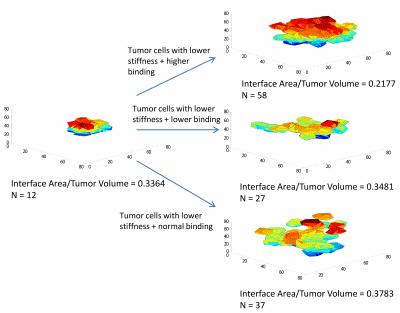 |
 |
||||||||||||||||||||||||
|
|
We hypothesize that cancerous behavior of cells is primarily a physical process driven by changes in cell mechanical properties that provide the forces required for cell growth, division and migration. The biochemical factors play mainly an indirect role by causing these mechanical property changes in cells. Based on this hypothesis, we have developed a computational model that describes the physical interaction of cells comprising a 3D homeostatic tissue and show how changes in the mechanical properties of a few cells within this tissue can induce uncontrolled division and cancerous behavior of these cells. The model focuses on an active role of cell mechanical property changes that influence cellular stretch and cell death or division probability is based on the resulting cell area as shown experimentally by Chen et al., Geometric control of cell life and death, Science (1997). Simulations based on this model show that an increase in the elastic compliance of a few cells can cause them to undergo uncontrolled division and evade cell death, representing cancerous behavior. It is also observed that for these mutated cells to grow into malignant tumors there exists a minimum starting number of initial mutated cells clumped together within the tissue. The simulations also show that an increase in inter-cellular adhesion amongst mutant cells results in rapidly growing compact malignant tumors while a decrease in the mutant cell adhesivity results in more spread-out, finger-like, stunted tumors (Fig. 1). These observations can be qualitatively compared to a number of experimental and clinical observations. The model provides a common mechanistic pathway linking the various biochemical factors that cause cell mechanical property changes to cancer progression as well as opens up novel avenues for cancer treatment focused on manipulating the cellular mechanical properties such as compliance and adhesivity. |
||||||||||||||||||||||||
|
|
|||||||||||||||||||||||||
| © 2011 Physics of Cancer | Soft Matter Physics Division, University of Leipzig. Imprint & Disclaimer | |||||||||||||||||||||||||
